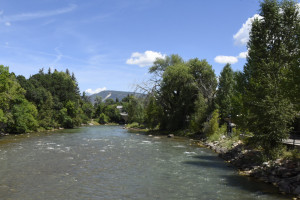CSU Extension has prepared the following information about irrigated agriculture and livestock watering in the area affected by the Gold King Mine spill in southwest Colorado.

While the constituents in the table below are what is expected to be found in this mine drainage, it is not known whether these are the only constituents of concern in the sediments or drainage waters. Caution is justified until local, state and federal authorities give the official word that the water is safe for irrigation and livestock watering.
Irrigated agriculture depends on adequate supplies of usable quality water. Following the mining waste spill on the Animas River, irrigators are wise to evaluate the ongoing reports of water quality release from the Environmental Protection Agency (EPA). For additional reassurance, diverted water and local sediments may also be evaluated at an EPA Certified Laboratory. For a list of Laboratories in Colorado, review CSU Extension Fact Sheet 0.520, Selecting an Analytical Laboratory. Another resource created to help evaluate drinking, livestock and irrigation water quality test results is available online at https://erams.com/wqtool/. The tool was developed by water experts at Colorado State University with input from colleagues at land-grant universities in the western U.S.
Guidelines for evaluating the quality of water for irrigation purposes have been assembled by various national and global water resource authorities, such as the United Nations Food and Agriculture Organization (FAO). A summary of these guidelines regarding contaminant concentrations particular to the EPA evaluations of the Animas River are summarized below:
| Table 1. Guidelines for Objectionable Long-Term Concentrations† of Water Quality for Agriculture | |||
| ICPMS Metals and Metalloids | Symbol | Irrigation water | Livestock water |
| micrograms per liter (μg/L) | micrograms per liter (μg/L) | ||
| Arsenic | As | 100 | 1,000 |
| Beryllium | Be | 100 | No guideline |
| Cadmium | Cd | 10 | 50 |
| Lead | Pb | 5000 | 100 |
| Selenium | Se | 20 | 100 |
| Table 2. Guidelines for Objectionable Long-Term Concentrations† of Water Quality for Agriculture | |||
| ICP Metals | Symbol | Irrigation water | Livestock water |
| micrograms per liter (μg/L) | micrograms per liter (μg/L) | ||
| Aluminum | Al | 5,000 | 5,000 |
| Boron | B | 500 | 5,000 |
| Chromium | Cr | 100 | 1,000 |
| Cobalt | Co | 50 | 1,000 |
| Copper | Cu | 200 | 500 |
| Iron | Fe | 5,000 | No Guideline |
| Manganese | Mn | 200 | No Guideline |
| Molybdenum | Mo | 10 | 300 |
| Nickel | Ni | 200 | 1,000 |
| Vanadium | V | 100 | 10 |
| Zinc | Zn | 2,000 | 25,000 |
†Note that concentrations will vary depending on the flow of water in the river.
There are various local entities that are available to address questions regarding background levels of Animas River water quality.
Animas River Stakeholders Group (ARSG). The mission of the Animas River Stakeholders Group (ARSG) is to improve water quality and habitats in the Animas River. The ARSG began in 1994 as an alternative process to determining appropriate water quality standards for the Upper Animas River Basin. www.animasriverstakeholdersgroup.org/
Animas-La Plata Water Conservancy District (ALPWCD). The general purpose of the ALPWCD includes acquisition and appropriation of Animas and La Plata river water for domestic, irrigation, power, manufacturing and other beneficial uses within the District territory.
The ALPWCD can be reached at (970) 247-2659
Animas-La Plata Operations, Maintenance, and Replacement (ALP OM&R) Association. The ALP OM&R was established in 2009 by an intergovernmental agreement by and among the Colorado Water Resources and Power Development Authority, the San Juan Water Commission, the La Plata Water Conservancy District, the Southern Ute Indian Tribe, the Navajo Nation and the Ute Mountain Ute Tribe. Each of the Association members is entitled to receive and use water from the Animas–La Plata Project. The ALP OM&R can be reached at (970) 385-7140
Perry E. Cabot
Water Resources Extension Specialist—Western Region
Office: (970) 434-3264 x 203 │ Cell: (719) 334-2558
Troy Bauder
Extension Specialist—Water Quality Sr. Research Associate
Office: (970) 491-4923